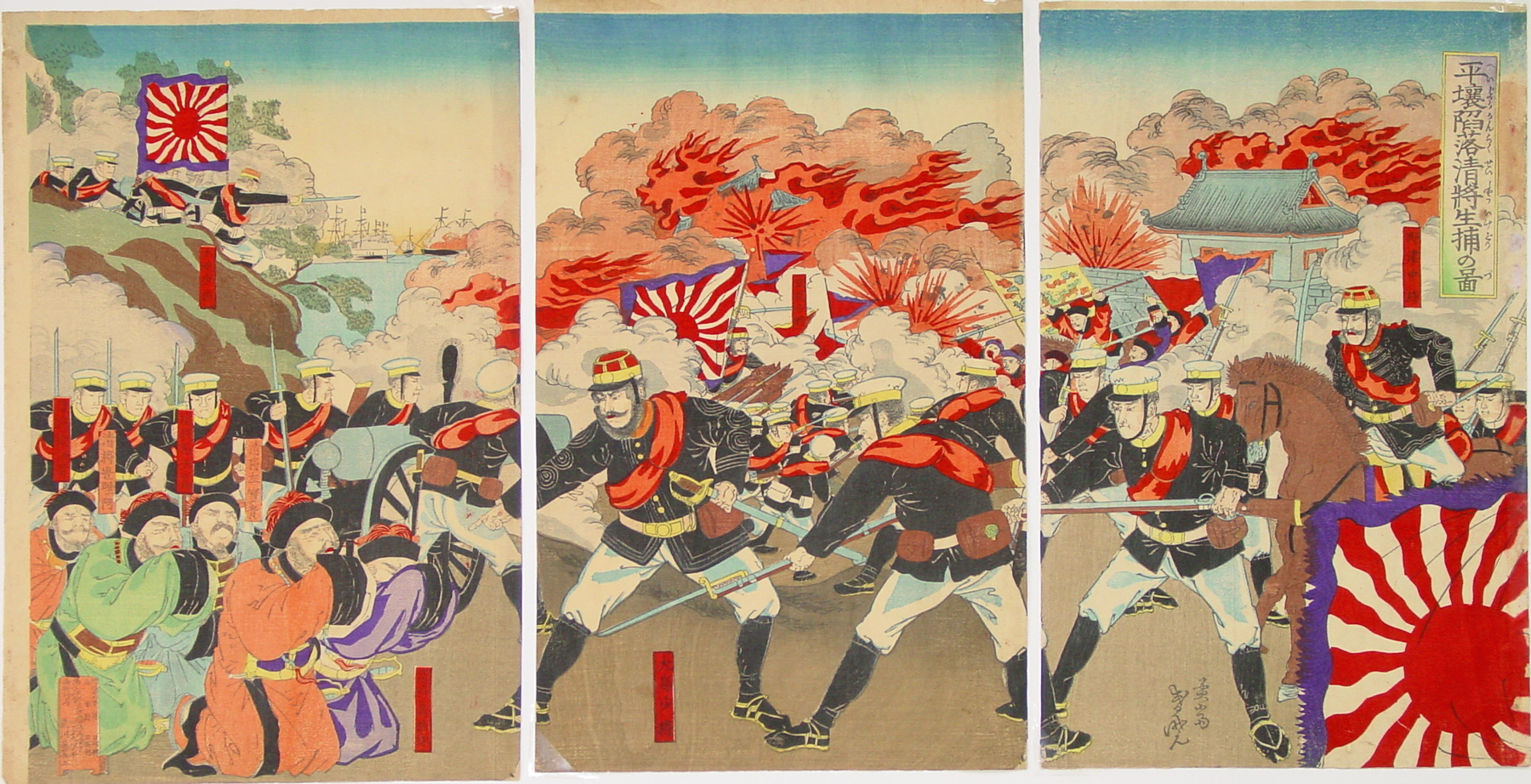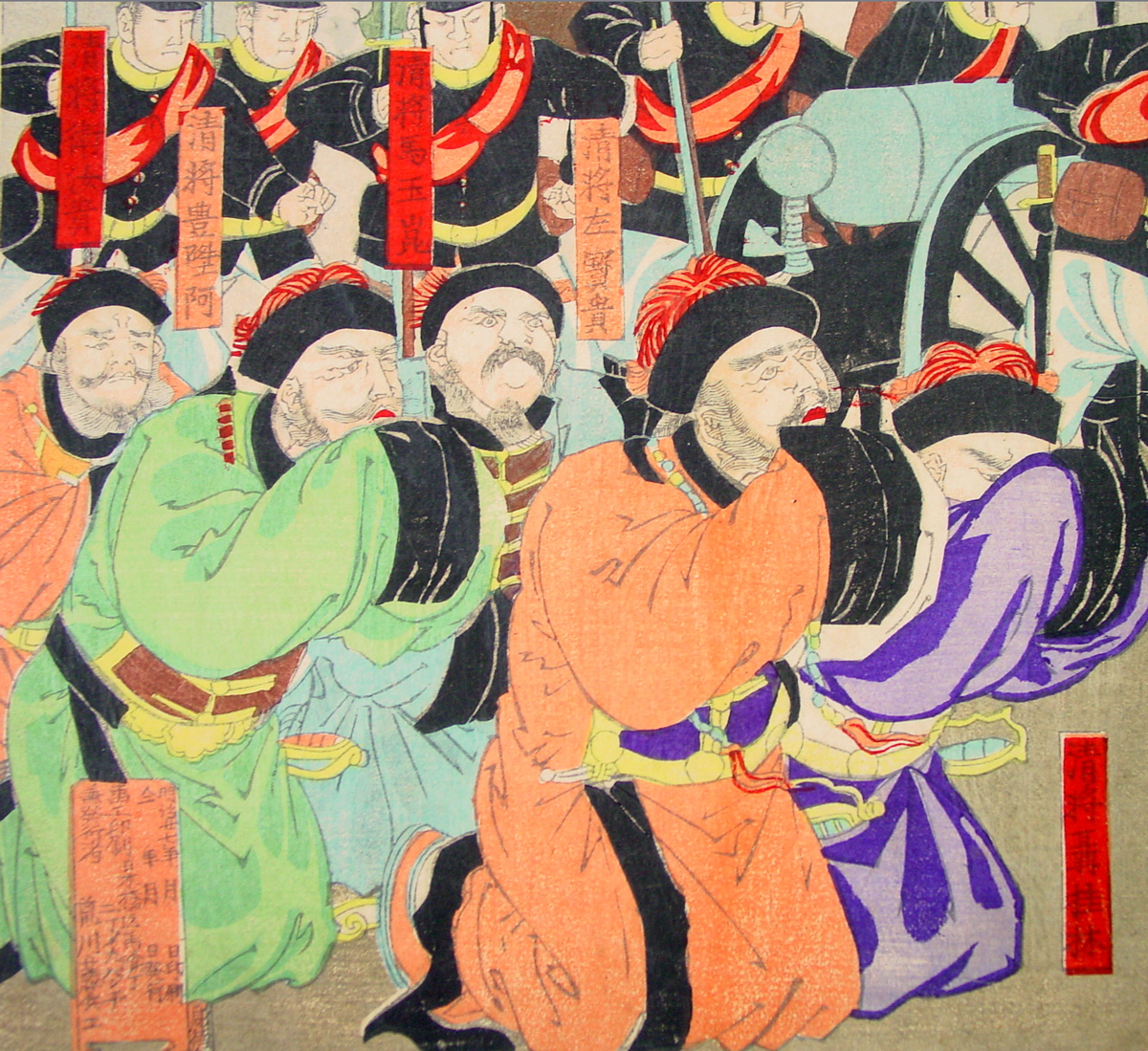About This Print
This print portrays the fierce fighting to capture Pyongyang (Pingyang), Korea from the Chinese during the Sino-Japanese War (1894-1895) and the resulting surrender and capture of five of the Chinese commanders defending the city. Interestingly, the Chinese Commander Tso Pao-kwei (Zuo Baogui) shown in the orange robe did not surrender and was killed in the fighting, suggesting that, as in many war prints, facts were manipulated for propaganda purposes.
Other Chinese commanders involved in the battle for Pyongyang include General Yeh Chih-ch'ao (Ye Zhichao, Ye Tzu-ch'ao), overall commander who fled the battle, Commander Wei Ju-kui, Commander Ma Yu-kwan and Commander Nieh Kweilin.
The four Japanese military commanders, all wearing either red or orange-topped caps and identified in the red cartouches near their likenesses, are:
Major General Ōshima 大島 少将 (center panel bottom left figure)
Major General Tatsumi (Tadzumi) 立見 少将 (center panel bottom background figure with red-topped hat and sword raised)
Lieutenant General Nozu (Nodzu) 野津 中将 (right panel on horse)
Major General Ōsako 大迫 少将 (left panel on ridge with drawn sword)
For other prints depicting this battle see Illustration of the Genzan Soldiers Marching on Pyongyang and the Fierce Battle Between the Japanese and Chinese Troops; Great Imperial Victory at the Fierce Battle at Pyong-Yang; Harada Jūkichi Opens the Genbu Gate from Within the Fort at Pyongyang; Sino-Japanese War: Japanese Military Might Captures Pyongyang; and Illustration of the Fierce Battle at the Surrender of Pyongyang Fort.
Source: Impressions of the Front: Woodcuts of the Sino-Japanese War, Shunpei Okamoto, Philadelphia Museum of Art, 1983, p. 13.
The Japanese began a full assault on September 15. The Chinese defense lacked coordinated leadership and organization and the troops lacked training and good morale. As the enemy neared, the Chinese supreme commander (General Yeh Chih-ch'ao ) proposed a retreat north to the Yalu River without fighting. As soon as Japanese troops penetrated one of the city gates, the supreme commander hoisted a surrender flag and fled in the night, abandoning his commanders. But the Chinese continued to fight from the ramparts. The north-wing commander Tso Pao-kwei led his troops to counterattack the Japanese, showing his courageous spirit until his heroic death in battle. Except for the collapse in the defense caused by the supreme commander’s cravenness, the Chinese could have continued to fight. Early on September 16, the Japanese entered the stronghold and found only a few Chinese soldiers. Pingyang was occupied without further fighting. The Chinese had retreated north across the Yalu River, thus losing their last position, as well as their prestige, in Korea.
last revision:
The four Japanese military commanders, all wearing either red or orange-topped caps and identified in the red cartouches near their likenesses, are:
Major General Ōshima 大島 少将 (center panel bottom left figure)
Major General Tatsumi (Tadzumi) 立見 少将 (center panel bottom background figure with red-topped hat and sword raised)
Lieutenant General Nozu (Nodzu) 野津 中将 (right panel on horse)
Major General Ōsako 大迫 少将 (left panel on ridge with drawn sword)
Five captured Chinese officers - detail
left to right: Wei Rugui (Wei Ju-kui) 衛汝貴; unread 豊陞阿; Ma Yu-kwan (Ma Yukun) 馬玉嵬; Zuo Baogui 左寶貴;
Nieh Kweilin (possibly Sei Kinlin, also seen as Nie Shicheng) 聶挂林
Note: Correlating the Japanese characters used in the cartouches naming the Chinese generals with the correct romanization in Hanyu pinyin
is well beyond my capabilities.
click on image to enlarge
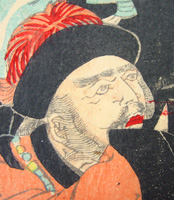 (Zuo Baogui) 左寶貴 | 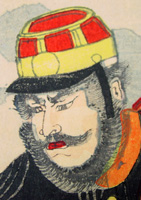 大島 | 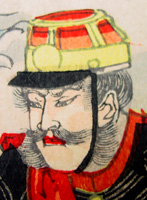 野津 |
The vanquished and the victors
For other prints depicting this battle see Illustration of the Genzan Soldiers Marching on Pyongyang and the Fierce Battle Between the Japanese and Chinese Troops; Great Imperial Victory at the Fierce Battle at Pyong-Yang; Harada Jūkichi Opens the Genbu Gate from Within the Fort at Pyongyang; Sino-Japanese War: Japanese Military Might Captures Pyongyang; and Illustration of the Fierce Battle at the Surrender of Pyongyang Fort.
The Battle for Pyongyang
In late July 1894, Japan began military operations in Korea against China, which had established itself as Korea's suzerain in 1860. Within a month Pyongyang was China's last position held in Korea and by September 16 they had lost this city to a Japanese assault.Source: Impressions of the Front: Woodcuts of the Sino-Japanese War, Shunpei Okamoto, Philadelphia Museum of Art, 1983, p. 13.
The Japanese began a full assault on September 15. The Chinese defense lacked coordinated leadership and organization and the troops lacked training and good morale. As the enemy neared, the Chinese supreme commander (General Yeh Chih-ch'ao ) proposed a retreat north to the Yalu River without fighting. As soon as Japanese troops penetrated one of the city gates, the supreme commander hoisted a surrender flag and fled in the night, abandoning his commanders. But the Chinese continued to fight from the ramparts. The north-wing commander Tso Pao-kwei led his troops to counterattack the Japanese, showing his courageous spirit until his heroic death in battle. Except for the collapse in the defense caused by the supreme commander’s cravenness, the Chinese could have continued to fight. Early on September 16, the Japanese entered the stronghold and found only a few Chinese soldiers. Pingyang was occupied without further fighting. The Chinese had retreated north across the Yalu River, thus losing their last position, as well as their prestige, in Korea.
Print Details
| IHL Catalog | #513 |
| Title or Description | Picture of Pyongyang Chinese Generals Capture and Surrender 平壤陷落清將生捕の圖 |
| Artist | Nagashima Shungyō (active 1882-1905) |
| Signature |  |
| Seal | not sealed |
| Publication Date | 1894 (Meiji 27) [as shown below on publisher's seal] |
| Publisher | 荒川藤兵 工 [荒川藤兵衛] |
| Engraver |  |
| Impression | excellent |
| Colors | excellent |
| condition | good - almost full-size separate sheets; unbacked; light wrinkling, minor offsetting and toning |
| Genre | nishiki-e; senso-e |
| Miscellaneous | |
| Format | vertical oban triptych |
| H x W Paper | 14 3/4 x 9 1/4 in. (37.5 x 23.5 cm) each sheet |
| Literature | |
| Collections This Print |
4/8/2021
3/30/2020
3/13/2020
11/27/2018

